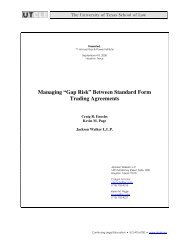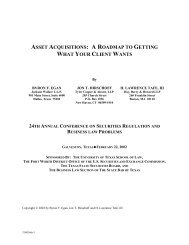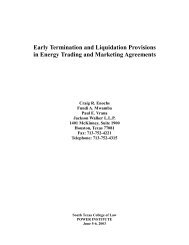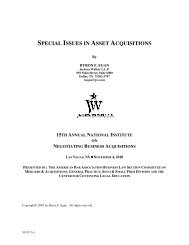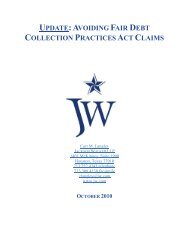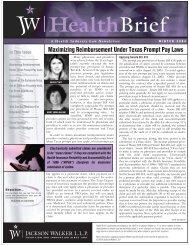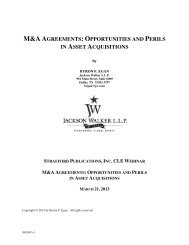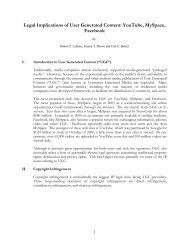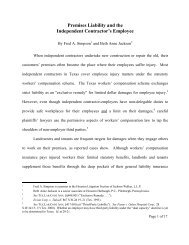busted m&a deals headed for litigation - Jackson Walker LLP
busted m&a deals headed for litigation - Jackson Walker LLP
busted m&a deals headed for litigation - Jackson Walker LLP
You also want an ePaper? Increase the reach of your titles
YUMPU automatically turns print PDFs into web optimized ePapers that Google loves.
Articles 5 and 6 contain covenants in which the parties commit to per<strong>for</strong>m (affirmative<br />
covenants) or not to per<strong>for</strong>m (negative covenants) certain acts in the period between signing the<br />
acquisition agreement and closing the acquisition. The main burden of the covenants falls on the<br />
Seller, which must take organizational steps toward consummating the acquisition and operate its<br />
business in the manner provided after signing the agreement and be<strong>for</strong>e the closing.<br />
Articles 7 and 8 contain conditions precedent to the obligations of the buyer and the seller,<br />
respectively, to consummate the acquisition. These sections specify what each party is entitled to<br />
expect from the other at the closing. If a condition is not satisfied by one party, the other party may<br />
be able to elect not to complete the acquisition.<br />
Article 9 outlines the circumstances in which each party may terminate the acquisition<br />
agreement and the effects of such termination.<br />
Article 10 contains certain additional covenants of the parties.<br />
Article 11 contains indemnification provisions giving each party specific remedies <strong>for</strong> the<br />
other’s breach of certain obligations under the acquisition agreement. These provisions cover<br />
matters such as calculation of damages, recovery of expenses and costs (including legal fees) in<br />
addition to damages (a right that may not exist absent an indemnification provision), and procedures<br />
<strong>for</strong> claiming damages.<br />
Article 12 contains comprehensive confidentiality and access to in<strong>for</strong>mation provisions,<br />
which are applicable both prior to and after the closing and supersede the confidentiality agreement<br />
previously entered into between the parties.<br />
Article 13 contains general provisions such as notice, severability, and choice of law.<br />
B. Letter of Intent<br />
In some transactions, the parties do not sign a binding agreement until the closing. If a letter<br />
of intent has been executed that includes a no-shop provision and gives the buyer adequate<br />
opportunity to conduct due diligence, the buyer may resist becoming contractually bound until it is<br />
ready to close. Conversely, the seller has an interest in not permitting extensive due diligence until<br />
the buyer is contractually bound. This is especially so in circumstances in which the buyer is a<br />
competitor or in which the seller is concerned that the due diligence process will necessitate or risk<br />
disclosure to employees, customers or competitors that the business is <strong>for</strong> sale.<br />
C. Gap Between Signing and Closing<br />
Occasionally it is the seller that is reluctant to sign be<strong>for</strong>e the closing. This may be the case,<br />
<strong>for</strong> example, if the seller has announced that the business is <strong>for</strong> sale, has several potential buyers and<br />
does not want to preclude talking to alternative buyers until the seller is certain that the transaction<br />
will close.<br />
Sometimes a simultaneous signing and closing occurs because the transaction simply evolves<br />
that way. The parties may be negotiating an agreement that contemplates a period between signing<br />
and closing, but the due diligence may proceed more rapidly than the negotiations, and it may<br />
4032470v.1<br />
- 21 -




